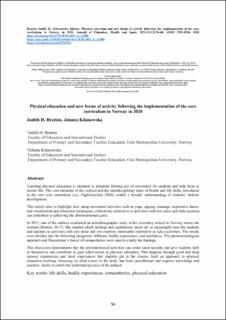| dc.contributor.author | Bratten, Judith Helene | |
| dc.contributor.author | Kilanowska, Jolanta | |
| dc.date.accessioned | 2022-03-28T12:19:22Z | |
| dc.date.available | 2022-03-28T12:19:22Z | |
| dc.date.created | 2022-01-31T23:22:40Z | |
| dc.date.issued | 2021-12-07 | |
| dc.identifier.citation | Journal of Education, Health and Sport formerly Journal of Health Sciences. 2021, 11 (12), 56-68. | en_US |
| dc.identifier.issn | 2391-8306 | |
| dc.identifier.uri | https://hdl.handle.net/11250/2988030 | |
| dc.description.abstract | Teaching physical education is intended to stimulate lifelong joy of movement for students and help them to master life. The core elements of this subject and the interdisciplinary topic of health and life skills, introduced in the new core curriculum (i.e., Fagfornyelsen 2020), enable a broader understanding of students’ holistic development. This article aims to highlight how using movement activities such as yoga, qigong, massage, expressive dance, and visualisation and relaxation techniques, collectively referred to as activities with low pulse and little exertion, can contribute to achieving the aforementioned goals. In 2017, one of the authors conducted an autoethnographic study at the secondary school in Norway where she worked (Bratten, 2017). She studied which feelings and experiences stood out as meaningful ones for students and teachers in activities with low pulse and low exertion, hereinafter referred to as LpLe-activities. The results were divided into the following categories: different, bodily experiences, and usefulness. The phenomenological approach and Shusterman’s theory of somaesthetics were used to clarify the findings. This discussion demonstrates that the aforementioned activities can create inner security and give students faith in themselves and contribute to goal achievement in physical education. This happens through good and deep sensory experiences and inner experiences that students get in the classes. Such an approach to physical education teaching, focussing on what occurs in the body, has been untraditional and requires knowledge and teachers’ desire to enrich the traditional practice of the subject. | en_US |
| dc.language.iso | eng | en_US |
| dc.publisher | Uniwersytetu Mikołaja Kopernika | en_US |
| dc.relation.ispartofseries | Journal of Education, Health and Sport formerly Journal of Health Sciences;Vol. 11 No. 12 (2021) | |
| dc.rights | Navngivelse-Ikkekommersiell-DelPåSammeVilkår 4.0 Internasjonal | * |
| dc.rights.uri | http://creativecommons.org/licenses/by-nc-sa/4.0/deed.no | * |
| dc.subject | Life skills | en_US |
| dc.subject | Bodily experiences | en_US |
| dc.subject | Somaesthetics | en_US |
| dc.subject | Physical education | en_US |
| dc.title | Physical education and new forms of activity following the implementation of the core curriculum in Norway in 2020 | en_US |
| dc.type | Peer reviewed | en_US |
| dc.type | Journal article | en_US |
| dc.description.version | publishedVersion | en_US |
| dc.rights.holder | © The Authors 2021 | en_US |
| cristin.ispublished | true | |
| cristin.fulltext | original | |
| cristin.qualitycode | 1 | |
| dc.identifier.doi | https://doi.org/10.12775/JEHS.2021.11.12.005 | |
| dc.identifier.cristin | 1995913 | |
| dc.source.journal | Journal of Education, Health and Sport formerly Journal of Health Sciences | en_US |
| dc.source.volume | 11 | en_US |
| dc.source.issue | 12 | en_US |
| dc.source.pagenumber | 56-68 | en_US |

